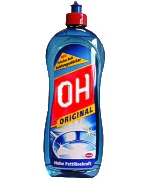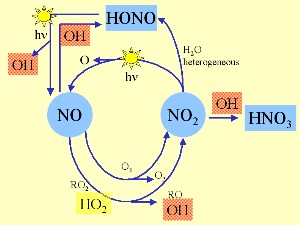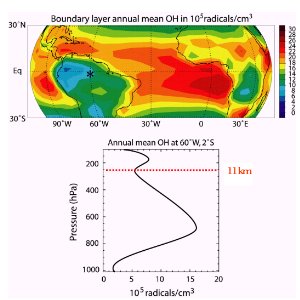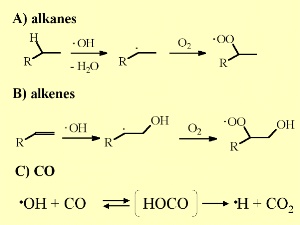 > ENC Master > Climate Encyclopaedia > Lower Atmosphere > more > 1. Oxidants & Observation > - oxidation & OH
> ENC Master > Climate Encyclopaedia > Lower Atmosphere > more > 1. Oxidants & Observation > - oxidation & OH
 |
|
|
|
Lower AtmosphereRead more! significantly changed ! |
Oxidation in the AtmosphereNumerous chemical compounds are emitted to the atmosphere and would accumulate if they would not be removed again. Removal can occur via dry deposition or wash out by rain (wet deposition). In particular for gaseous organic compounds removal from the atmosphere is easier if they are transferred into a less volatile, water soluble oxidised state ...
|
|
Oxidation in a chemical sense does not necessarily mean a reaction with oxygen containing compounds. But in the air in most cases oxygen is involved. There are three major oxidants which govern such processes in the atmosphere: the hydroxyl radical OH
|
|
How is OH formed?OH governs atmospheric chemistry during the day, because its formation primarily depends on the radiation from the sun. The initial reaction (above) is the cracking of ozone by sunlight (photolysis) taking place at wavelenghts less than 310 nm, followed by the reaction of the formed O atom with water. This is why a basic amount of ozone in the troposphere is essential for its chemistry, although too much is not healthy.
|
How much OH is formed?Since OH is an extremely reactive radical it reacts as soon as it is formed. It's lifetime is about a second or less. This means the concentration is extremely low, in the range of 1x105 to 2x107 molecules cm-3. For sea level pressure this is a mixing ratio of 0.01 - 1 ppt (pmol/mol). |
|
But it decreases in particular with the latitude because not only the water vapour concentration decreases but also the intensity and the duration of sunlight towards the poles. How does OH react?The image on the right shows an interesting effect over the tropical rainforest. The OH concentration decreases near the ground. What is the reason? Many organic compounds, first of all isoprene, are emitted by the forest and react with OH. Therefore a strong OH removal occurs close to the ground. It is consumed in chemical reactions. OH has a strong tendency to abstract an hydrogen atom from organic compounds RH whenever possible and to form water H2O. In the next step the radical R
|
|
|
However, worldwide OH does not react first of all with organic compounds from forests. Organic gases contribute with 30% to the removal of OH plus another 15% for methane, the most important and smallest of the organic molecules. The main gas which reacts with OH is carbon monoxide (40%) and the remaining 15% react with ozone O3, hydroperoxy radicals HO2 and hydrogen H2.
|
|
Reacting with small alkenes, a special class of organic compounds, OH tends to add to the double bond as long as the saturated rest is not much bigger and H abstraction statistically favoured. Also here a formation of peroxides occurs.
|
Although OH is the most important oxidant in the atmosphere, its night time concentration is close to zero because radiation is needed for the formation. This is why during dark periods and during the night, the chemistry of nitrate NO3 and also ozone O3 becomes more important.
|
|
* The mixing ratio ppb or ppm (= 1 molecule among 1 billion molecules, or 1 molecule among 1 million molecules) is often used in scientific publications as well as in other literature on atmospheric and climate science. We also use it here in the Climate Encyclopaedia. However, more correct is the unit 1 nmol/mol (= 1 ppb) or 1 µmol/mol (= 1 ppm). Because the quantity of molecules n is measured in the unit mol.
|
About this page:author: Dr. Elmar Uherek - Max Planck Institute for Chemistry, Mainz
|







